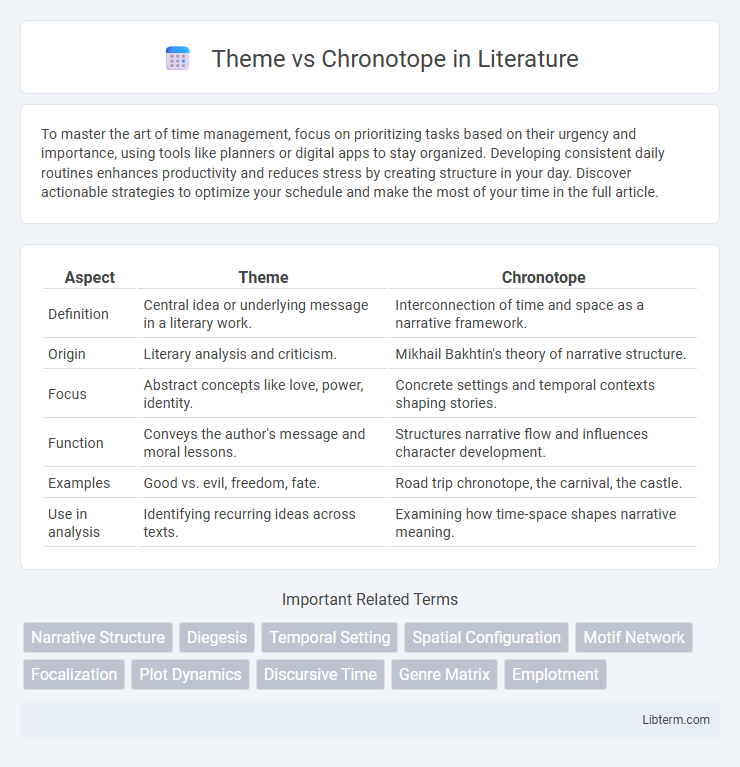To master the art of time management, focus on prioritizing tasks based on their urgency and importance, using tools like planners or digital apps to stay organized. Developing consistent daily routines enhances productivity and reduces stress by creating structure in your day. Discover actionable strategies to optimize your schedule and make the most of your time in the full article.
Table of Comparison
| Aspect | Theme | Chronotope |
|---|---|---|
| Definition | Central idea or underlying message in a literary work. | Interconnection of time and space as a narrative framework. |
| Origin | Literary analysis and criticism. | Mikhail Bakhtin's theory of narrative structure. |
| Focus | Abstract concepts like love, power, identity. | Concrete settings and temporal contexts shaping stories. |
| Function | Conveys the author's message and moral lessons. | Structures narrative flow and influences character development. |
| Examples | Good vs. evil, freedom, fate. | Road trip chronotope, the carnival, the castle. |
| Use in analysis | Identifying recurring ideas across texts. | Examining how time-space shapes narrative meaning. |
Defining Theme: Core Concepts
Theme encapsulates the fundamental ideas and underlying messages that a literary work conveys, reflecting universal human experiences and moral questions. It operates as the central topic or insight around which the narrative is structured, often revealing the author's intent and the text's deeper meanings. Unlike the chronotope, which focuses on the interaction of time and space, theme is primarily concerned with the conceptual and emotional essence driving the story's significance.
Understanding Chronotope: Time-Space Frameworks
The concept of chronotope, introduced by Mikhail Bakhtin, explores the intrinsic connection between time and space in literature, shaping narrative structure and meaning. Unlike theme, which centers on central ideas or messages, chronotope functions as a framework where temporal and spatial dimensions fuse to influence characters' experiences and events' unfolding. Understanding chronotope reveals how stories situate actions within specific cultural and historical contexts, enriching interpretation through the dynamic interplay of time and place.
Key Differences Between Theme and Chronotope
Theme represents the central idea or underlying message of a literary work, reflecting abstract concepts such as love, power, or identity. Chronotope refers to the intrinsic connection between time and space within a narrative, shaping how events are structured and experienced. The key difference lies in theme addressing what a story means, while chronotope concerns when and where the story unfolds, influencing narrative context and meaning.
Historical Origins of Theme and Chronotope
Themes originate from literature as underlying messages or central ideas that convey universal human experiences, emerging prominently in ancient Greek tragedies and epic poetry. The concept of the chronotope, coined by literary theorist Mikhail Bakhtin, refers to the intrinsic connection between temporal and spatial relationships in narratives, rooted in the study of Russian formalism and dialogism. Understanding the historical origins of both theme and chronotope enhances the analysis of literary works by revealing how time, space, and core ideas interact to shape storytelling.
Thematic Development in Literature
Thematic development in literature explores how central ideas evolve through characters, settings, and plot, while the chronotope shapes these themes by linking narrative time and space, influencing the reader's perception of thematic progression. The theme provides the conceptual framework, and the chronotope situates this framework within a temporal-spatial context that deepens meaning. Understanding the interplay between theme and chronotope is essential for analyzing how literature reflects cultural and historical realities.
Chronotope’s Role in Shaping Narrative
Chronotope, a concept introduced by Mikhail Bakhtin, integrates time and space into a cohesive narrative framework, shaping the way events unfold and characters interact within a story. It establishes the temporal and spatial settings that influence the plot's progression, creating a meaningful context that enhances readers' understanding and emotional engagement. By defining the narrative's structure, the chronotope facilitates the thematic exploration of social and cultural dynamics embedded within the story.
Interplay of Theme and Chronotope in Storytelling
Theme and chronotope interact dynamically in storytelling, where chronotope--defined as the intrinsic connectedness of temporal and spatial relationships--shapes the narrative's thematic exploration by grounding abstract ideas in specific settings and times. This interplay allows themes such as identity, power, or freedom to be experienced through evolving spatial-temporal contexts, enhancing the reader's understanding of the narrative's core messages. By integrating theme with chronotope, authors create layered meanings that resonate through the interconnected fabric of time, space, and human experience.
Examples of Theme vs Chronotope in Classic Works
In Dostoevsky's *Crime and Punishment*, the theme of guilt and redemption intersects with the chronotope of St. Petersburg's claustrophobic urban environment, reflecting the psychological turmoil of the protagonist. Tolstoy's *War and Peace* employs the theme of fate versus free will within the expansive chronotope of 19th-century Russian society and Napoleonic wars, highlighting individual experiences against historical forces. In Kafka's *The Metamorphosis*, the theme of alienation is reinforced by the confined domestic chronotope, emphasizing the protagonist's physical and emotional isolation.
Analytical Approaches: Studying Theme and Chronotope
Analytical approaches to theme and chronotope prioritize the identification of recurring motifs and narrative structures that reveal deeper meanings within texts. The study of theme involves examining the underlying messages and ideological frameworks conveyed through character development and plot progression. Chronotope analysis focuses on the interconnectedness of time and space, exploring how temporal and spatial settings influence narrative dynamics and reader interpretation.
The Impact of Theme and Chronotope on Reader Experience
The impact of theme and chronotope on reader experience lies in how they shape narrative meaning and temporal-spatial context, respectively. Themes provide the underlying messages or moral questions, engaging readers on an intellectual and emotional level, while chronotopes anchor the story in specific time-space frameworks that influence pacing and atmosphere. Together, these elements create immersive and resonant storytelling by aligning readers' interpretations with the story's conceptual and contextual dimensions.
Theme Infographic

 libterm.com
libterm.com